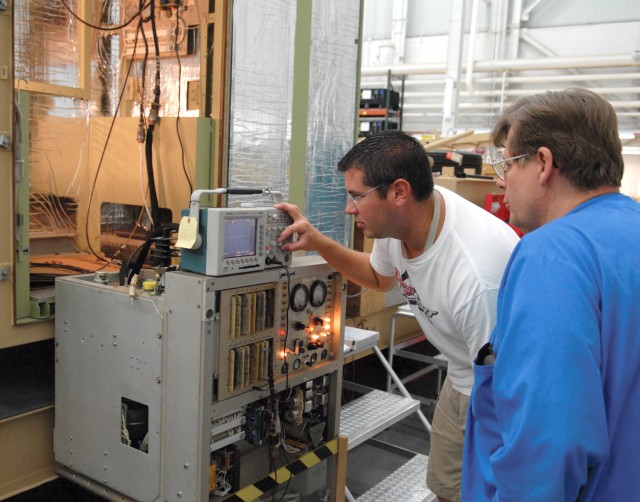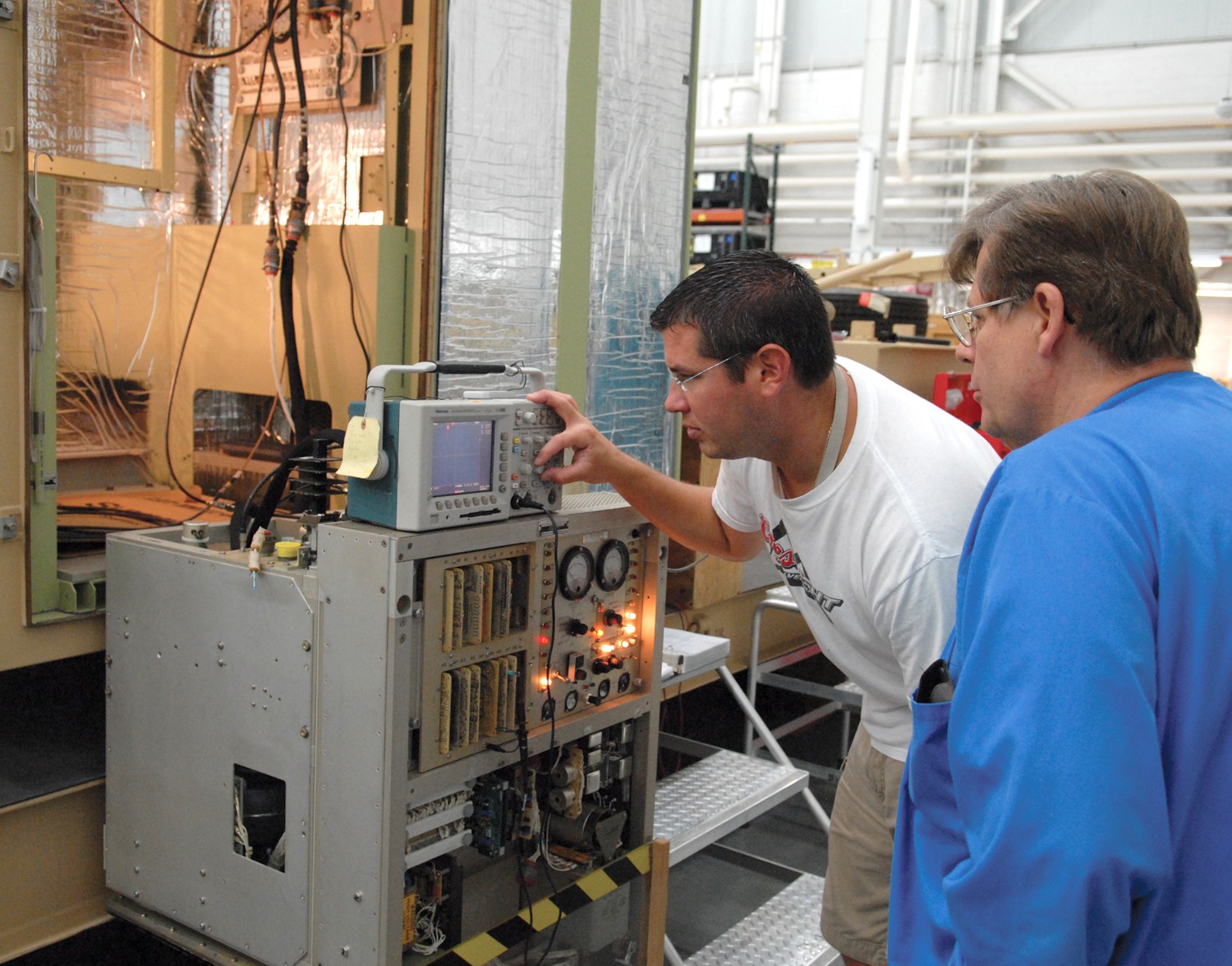TOBYHANNA ARMY DEPOT, PA. - Continuous improvements to the support of a radar used to train pilots have made the mission a candidate for a national-level quality prize.
Mini-MUTES Branch technicians have worked on the AN/MST-T1(V) Miniature Multiple Threat Emitter System for about 11 years. The Mini-MUTES is an Identify Friend or Foe tracking and training simulator that provides realistic threat signals for pilots and aircrews. The system can replicate threats such as surface-to-air missiles, early warning radar systems, anti-aircraft artillery and airborne intercept systems.
The Shingo Prize program recognizes private and public sector organizations that successfully apply Lean Six Sigma techniques to improve the quality and efficiency of their operations. It is regarded as the premier manufacturing award recognition program for North America. As part of the Shingo Prize mission and model, the Prize highlights the value of using Lean/world-class manufacturing practices to attain world-class status.
Lean is a quality improvement and business strategy that emphasizes reducing defects, repair cycle time and costs.
"For the first few years of the mission, we were scattered in three areas, Building 4, Bay 6; Warehouse 3, bay 1 and Building 3005," said Jeff O'Neill, acting chief, Range Threat Systems Division. "The system was new to us, so we had a learning curve."
As technicians became familiar with the mission, they began making improvements, such as a new floor layout for a portion of 4-6. This prepared the branch for its first Value Stream Analysis (VSA) in 2005. They worked with the Productivity Improvement and Innovation, Systems Integration and Support, Production Management and Production Engineering directorates.
"We did a VSA on our entire overhaul process," said Tom Weir, electronics mechanic leader. "Our average RCT (Repair Cycle Time) at that time was 718 days." The target is 365 days.
O'Neill noted that those were the early days of Lean and they were one of the first depot organizations to begin implementing Lean practices and techniques. The branch held a Plan and Layout a Process (2P) event with Firefinder organizations, with who they shared space.
"We completed a Value Stream Map and identified areas for improvement," O'Neill said. "One of the most significant changes to come from that was consolidating part of the mission within 4-6, plus we created a new floor layout for the enclosure overhaul process."
The enclosure is the component that houses electronics equipment on the Mini MUTES.
"That was definitely the beginning stages of improvements," Weir noted.
Improvements were made to increase efficiency for the Azimuth and Elevation Drive overhaul area and Lean techniques were adopted to restructure the Line Replaceable Units area.
In 2006, a Rapid Improvement Event (RIE) was held for the enclosures, during which branch employees developed a standard work document.
"It's similar to a manual; anyone can open it and they will know what to do to repair the enclosure equipment," said Brian Wilcox, electronics mechanic. "We began reorganizing our shop, not just with PII, but on our own, with 6S events. We reviewed our teardown process, kitting and intershop palletization."
6S identifies the various waste in the process such as injuries, defects, excessive inventory, over production, waiting, unnecessary movement and processing waste.
Even though they began to realize savings in time and increased efficiency, it was an incident in 2007 that drove home the need for even more improvements.
"We shipped a system to Poinsett Electronic Combat Range in South Carolina and there were serious quality issues that required me and Paul Williams from Quality Management Division to conduct a site visit," O'Neill said. "It opened our eyes to the need for continuous improvements to quality."
"We started digging deeper into our processes to find and improve or correct how we carried our mission," Weir said.
Employees went through each failure of the Poinsett incident, noting what went wrong and implementing changes. For example, a Final System Checklist was developed by branch employees.
"We use that process to this day for every system we ship out," O'Neill said. "We learned from that incident, made improvements and have not had a similar call again. Our Customer Satisfaction Surveys reflect that improvement."
After that, they began to see more dramatic improvements to the RCT. In 2005, their average RCT was 718 days. By 2008, it had dropped to 450 days. In June 2009, they completed a system that took 364 days, one day below the target.
"The improvements that we began making in 2005 took time to pay off," Wilcox said. "We have now met or exceeded the target time for the five systems we've completed since that system was completed in June 2009."
Despite this success, the branch held another VSA in February to help reach new goals, such as reducing the RCT to 320 days, reducing the Unit Funded Cost (UFC) by about 10 percent and incorporating the fielding cost into the UFC.
"One of the areas we've targeted for improvement is the rain test; currently it's at 85 percent failure, so most of the systems are failing this test the first time around," O'Neill said. "We are going for a first-time pass for every system."
Branch employees along with Production Engineering and Quality Management Division are developing an improved rain test procedure that includes a key point sheet that will remind technicians to check that all the preparation work is carried out before the test, such as proper gaskets being installed on cable connectors.
A second improvement is to reduce travel time by taking a system directly from the range threat test pad to Building 9 for painting, rather than taking it back to their shop to mark areas requiring touch up painting.
"That really is the painter area of expertise and we realized it was a non-value added step," Weir said. "Once it is implemented, it will save us 1,360 feet of travel round trip, or about a quarter of a mile, and reduce travel time by 99 percent. Instead of 218 hours, it will be one hour."
Since that VSA, three RIEs have been held to move the branch toward its goal of a 320-day RCT. In March, a RIE on the Prime Shop Enclosure overhaul was performed. On May 3, employees held a RIE to identify cost savings and process improvements for the evaluation, inventory and disassembly processes.
"This month, we are completing an RIE for the Line Replaceable Unit process," O'Neill said.
Tobyhanna Army Depot is the Defense Department's largest center for the repair, overhaul and fabrication of a wide variety of electronics systems and components, from tactical field radios to the ground terminals for the defense satellite communications network. Tobyhanna's missions support all branches of the Armed Forces.
About 5,600 personnel are employed at Tobyhanna, which is located in the Pocono Mountains of northeastern Pennsylvania.
Tobyhanna Army Depot is part of the U.S. Army CECOM Life Cycle Management Command. Headquartered at Fort Monmouth, N.J., the command's mission is to research, develop, acquire, field and sustain communications, command, control computer, intelligence, electronic warfare and sensors capabilities for the Armed Forces.


Social Sharing